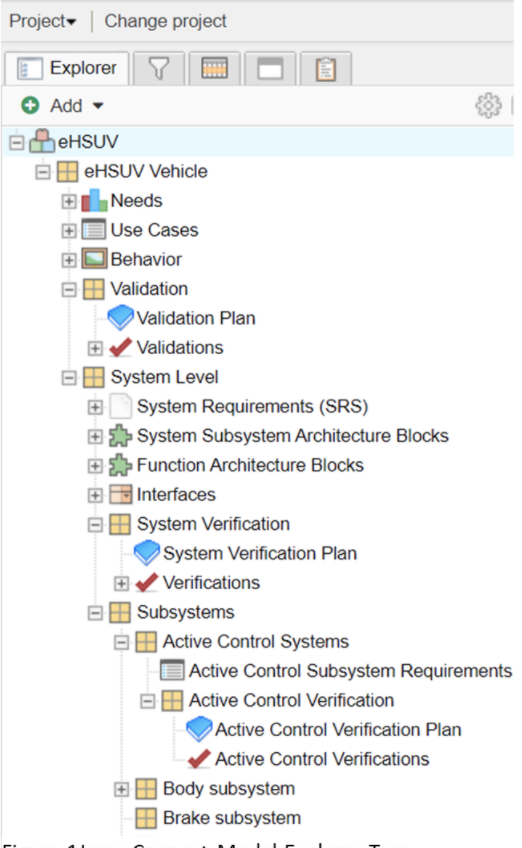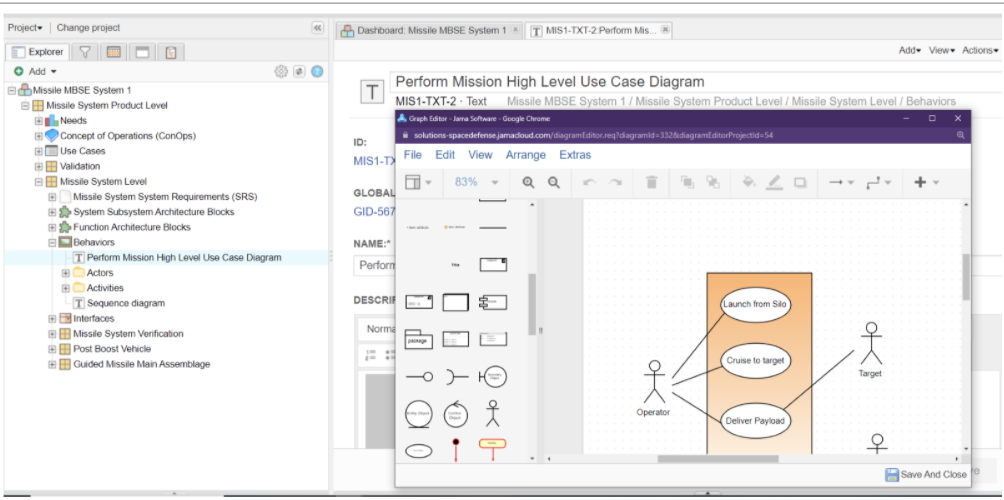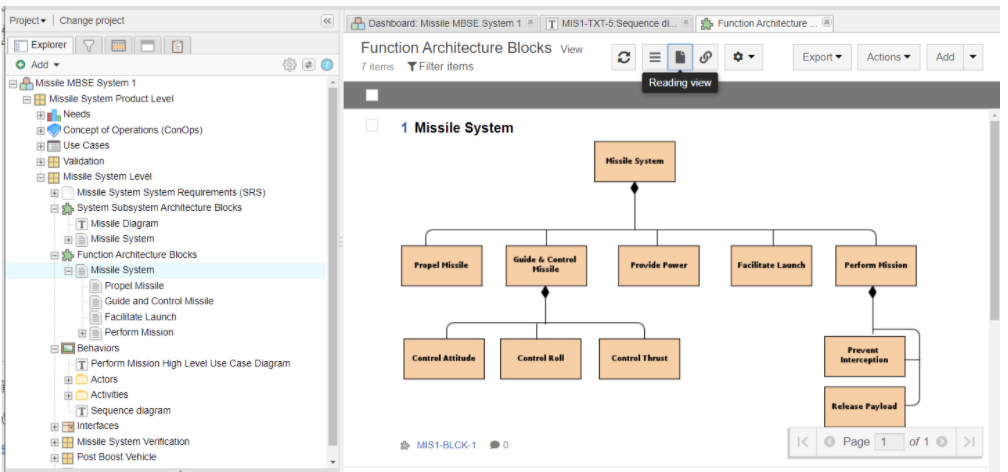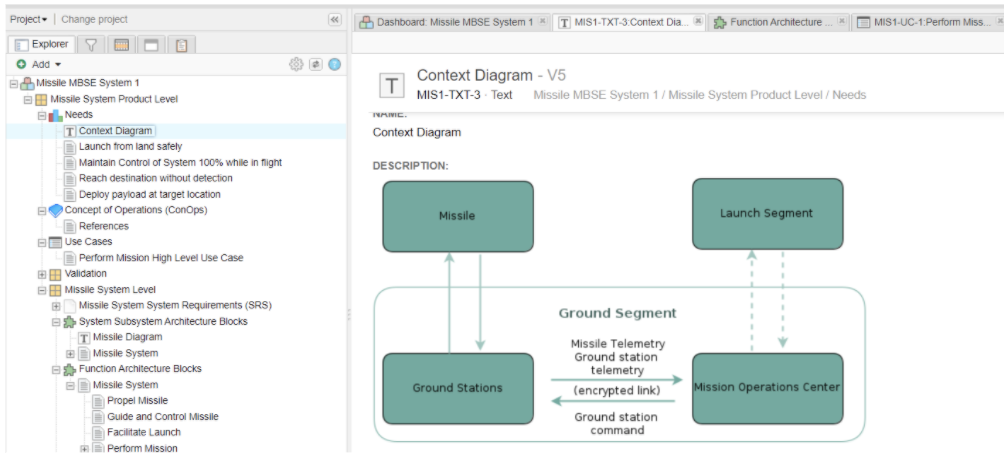
For companies building complex systems whose stakeholders come from diverse engineering and business disciplines and need to have very precise and efficient communications, Jama Connect provides a collaborative, 100% web-based MBSE platform and a proven systems engineering approach to product development. Jama Connect provides a path to companies embracing MBSE where the application of collaboration, modeling, and methods reduces time and effort across the lifecycle. We call that path Jama Connect for Traceable MBSE™.
Jama Connect for Traceable MBSE is a single platform that combines requirements, architectures, behaviors, and V&V into a single model of the system by applying structure for the data; rules for the data; and a consistent interface language between parts of the system. A Jama Connect model provides engineers, project managers, business analysts, or any stakeholder, an organized way to address all aspects of the system consistently with the assurance of completeness.
MBSE Defined by Industry
The International Council on Systems Engineering (INCOSE) describes MBSE as the “formalized application of modeling to support system requirements, design, analysis, verification, and validation activities beginning in the conceptual design phase and continuing through-out development and later lifecycle phases.”
NASA says MBSE “involves applying software-based tools to capture systems engineering evidence—typically called “artifacts”—in a systematic, disciplined way that allows people to manage complexity while communicating effectively across the life cycle of a system.
What is a model? Don’t be fooled.
It is a myth that a system model can only be created in a UML or SysML tool. Models can be expressed texturally, mathematically, visually, or physically and are meant to assist in helping people look at problems from different directions. Jama Connect represents a model as a project containing textural data items, views, graphical diagrams, and collaboration content.
NASA’s definition provides a good deal of information, but they don’t even use the word “model” in their description. Lenny Delligatti, one of the most respected MBSE experts in the world wrote that, “A modeling method is something like a road map; it’s a documented set of design tasks that a modeling team performs to create a system model. More precisely, it’s a documented set of design tasks that ensures that everyone on the team is building the system model consistently and working toward a common end point. Without such guidance, there will be wide variance in the breadth, depth, and fidelity that each member of the team builds into the system model.”
For example, a switch in a system is expecting the command “On” but for some reason receives the command “Start.” The switch will not function. The “On” and “Start” is the communication language and must be consistent.
What in simple terms is a model then? Wikipedia tells us that a “model is an informative representation of an object, person or system” and INCOSE defines a model as “a simplified version of a concept, phenomenon, relationship, structure or system.”
Before the invention of SysML, we used to use a document called an “Interface Control Document (ICD)” to describe the syntax of interfaces between different parts of a system, often physical. While essential, the ICD lacked the ability to describe scenarios which the interfaces would be used for. While a SysML model allows for communication of scenarios to be documented, it often lacks the ability to communicate the depth of requirement needed to describe the core workings of each part. This puts a heavy onus on the verification needed to ensure a part on its own was working as intended.
While SysML is a wonderful language to represent abstractions and there are some fine tools out there that let you do some powerful things (I want to say something different here); it is still immature in the core aspects of systems engineering as it relates to communication, cross-domain collaboration, project management including cost and schedule, and oversight of verification and validation activities to name a few.
RELATED: MBSE Made Easy – Overcoming the Organizational Challenges
Jama Connect for Traceable MBSE™ – The Nuts and Bolts

The Jama Connect for Traceable MBSE framework takes requirements, architectures, behaviors, and V&V and forms their data into a query-able mesh. As development progresses the mesh becomes more stitched together. A built-in ruleset that uses a consistent language, constrains users to create the correct associations between the data elements. The framework’s ruleset eliminates risk that manual methods or tools lacking these constraints introduce. Jama Connect for Traceable MBSE also supports leveling – representation of system decomposition within a model. Each successive level will follow the same consistent ruleset.
Visualization is an important part of Jama Connect for Traceable MBSE and plays a major role in communication of information and ideas. Data is easily visualized in an easy to navigate hierarchal tree view. This view not only displays the content of the data but also how the elements are tied to each other. These structures can be represented visually as a series of diagrams within the model.
Requirements
Requirements are typically the first data elements to be worked on in the model. Jama Connect for Traceable MBSE’s flexibility gives users the ability to define unlimited levels of requirements – even those considered outside the “system” level. A Need Requirement which is an input to the systems engineering process, might consist of multiple types such as: user needs, ConOPS, business requirements, mission objectives, goals, regulatory requirements, or even constraints to name a few. A needs analysis is performed to flesh out those requirements which are human-centric. Systems engineers will analyze all the broad and at times abstract needs and then refine them into system level requirements that are representative of the system and might describe all the functions that the system shall deliver as well as non-functional characteristics such as performance or reliability of the system.
In Jama Connect each need and system requirement is captured as a unique entity with its own ID. As a single entity it can then be managed, version controlled, and linked to other entities. When using Jama Connect for Traceable MBSE framework, it provides mechanisms that keep needs and system requirements appropriately leveled and describe how they are linked to each other. This link itself also has a name and is called “derivedReq” which is similar terminology used in the SysML language.
Behaviors
Behaviors assist the systems engineer in identifying the functions, sub-functions, and interactions that the system performs. Behaviors can be elicited from needs and requirements through techniques such as use cases, activities, states, interactions, sequences and more. Behaviors are most often in the form of a verb (ex: regulate voltage, make deposit, heat water, charge controller, brake…). Capturing behaviors adds value because they help explain how the system will work and sometimes more importantly, what could go wrong. Behavior can assist in establishing the cost and complexity of the system. Functions can be analyzed and become a deciding factor for which requirements are then used to build the system.
In Jama Connect behaviors can be richly annotated so one can capture the full reasoning. This is extremely useful to stakeholders that are not necessarily modelers yet need this information to make informed decisions.
Architecture
Application of MBSE is not complete without tying in architectures and making them be a central point of data. Architectures can be defined to conceptually represent functions of the system, structure of the system to subsystems, physical components of the system, or even behaviors of the system. An architecture is organized so that its own structure conveys meaning and relationships between its members. In Jama Connect, architecture objects can be managed as discrete elements where relationships to other data such as requirements can be made. It is also possible to create diagram to illustrate the relationships between the elements.
V&V
The verification and validation of the model and its entities within it is the last major domain for MBSE. Any element defined within the model can be verified or validated through means of analysis alone, review, trace demonstration, or even by test execution collecting pass/fail status. An MBSE model
Jama Connect for Traceable MBSE tests and validates system characteristics early with engineers and stakeholders for fast feedback on design decisions and phase it is believed that this will:
- Predict performance
- Verify design choices
- Meet stakeholder expectations
- Avoid failures
- Reduce risk
Visualization
Visualizing the model is an integral part of MBSE. As maturity of stakeholder’s fluency in MBSE increases, reliance on heavy text in some areas will decline. Jama Connect facilitates the best of both worlds by providing fully textural representations of data as well as diagrams that can easily be annotated to describe the purpose behind the “line” the connection between two objects.
Why Jama Connect for Traceable MBSE?
The inefficiency of non-integrated data leads to wrong decisions. When MBSE is done properly, the result is an overall reduction of development risks. Jama Connect for Traceable MBSE provides a flexible framework that is 100% web browser based for capturing and communicating the model to all stakeholders. The model can be queried programmatically to surface up gaps in the model, display progress information, and be validated against the rules of the framework. These rules enforce users to create and relate data in a consistent way. Jama Connect for Traceable MBSE gives users easy graphical and textural views of information in real time and is structurally SysML ready if mature organizations wish to integrate Jama with these specialized tools. Most importantly, users do not need lengthy indoctrination into the semantics of modeling which is required for modeling tools. Jama Connect as a data-centric tool, does not have this barrier and so is much easier for every stakeholder to adopt.
- [Webinar Recap] Accelerate Your ECSS Standards Compliance with Jama Connect® - February 27, 2025
- The New ARP4754B and Techniques in Jama Connect® for Airborne Systems - February 13, 2025
- [Webinar Recap] The New ARP4754B: Tips for Engineers & Quality Teams - December 30, 2024


